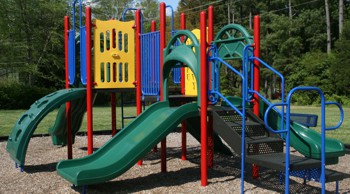|
Posted April 12, 2023
Where’s the Challenge?
Have we become so obsessed with protecting our children that we have deprived them of challenge? This is a
newsletter about play, so let’s talk about contemporary playgrounds. Every community has them, many of them.
Every elementary school has one.
If you look past the bright colors and arrangement, they are all basically
the same. A platform you climb up to with stairs, rope net or slanted “rock wall”. Then you peek through a
few holes or a fake telescope, spin a plastic ship’s steering wheel that does nothing and then slide down
a short slide – maybe straight, maybe curved. There are some springy things and a few swings with short
ropes. If you are 3 or 4, this might be exciting a couple of times, but where is the challenge that pushes
kids to grow, physically and mentally?
Every one of these playgrounds cost $100,000 plus, and then there
is landscaping and installation costs. It may be an insurance companies dream, but where is the challenge to encourage our
children’s development?

Here’s what play specialist Peter Gray, PhD has to say....
“Play serves many valuable purposes.
It is a means by which children develop their physical, intellectual, emotional, social, and moral
capacities. It is a means of creating and preserving friendships. It also provides a state of mind
that, in adults as well as children, is uniquely suited for high-level reasoning, insightful problem
solving, and all sorts of creative endeavors.”
“The characteristics of play all have to do with motivation and mental attitude, not with the overt
form of the behavior. Two people might be throwing a ball, or pounding nails, or typing words on a
computer, and one might be playing while the other is not. To tell which one is playing and which one
is not, you have to infer from their expressions and the details of their actions something about why
they are doing what they are doing and their attitude toward it.”
– Play is self-chosen and self-directed.
– Play is activity in which means are more valued than ends.
– Play has structure, or rules, which are not dictated by physical necessity but emanate from the minds of the players.
– Play is imaginative, non-literal, mentally removed in some way from “real” or “serious” life.
– Play involves an active, alert, but non-stressed frame of mind.
One of the critical definitions of play comes from the kids themselves. If an adult is involved, it’s
not play! Kids need the autonomy of self direction to experience the full aspect of play. They choose
how they will interact with their world.
This is a hard concept for both parents and teachers. Let go.
Let them figure it out, set the rules, problem solve. As soon as we intervene... it’s now a lesson, or
something else. Watching your kids from a distance is OK, they want to know that you are there for them
if they ask for help. Even better, drop the adulthood and “play with them”. Let them call all the shots and
make the rules.
If there are lots of other kids around, they need to learn how to interact with
the unknown relationships. If someone becomes pushy, that’s OK. They will just quit and find someone
else to play with that is more friendly.
From a kids perspective, a playground should be open ended in how to use the “equipment”. Does the
environment provide challenge and testing of skills? Does it silently tease one into exploring the
unknown – something I’ve never tried before? Do I have to evaluate the danger involved and how to stay
safe and have fun too?
A good playground has challenges that keep kids interested even as they grow and
develop new skills and understanding of life. Last year I couldn’t do that, but this year I can! The
excitement of discovery is also important. Are the challenges too obvious, or do I just have to “play”
with it until I figure out how it works? The child’s inquisitiveness needs to be fully engaged.
Discovery Park is not an amusement park with “rides”. If something is going to happen, it’s the child’s
job to make it happen.
Let’s have
some fun
at Discovery Park!

“When I started designing Discovery Park, it was by intuition. As I continue to expand the activities,
I am much more contemplative of how kids will interact with this new adventure. Obviously it needs to be safe,
but it also needs to challenge.
Kids get hurt on traditional playgrounds because they are bored with the
obvious use and start climbing on the structures in unexpected ways. That can happen on any playground,
including Discovery Park. But if there is already a degree of challenge in every activity, then the kid
has to evaluate more carefully how to use this activity safely and still have fun. If we assume the playground
is so boringly safe that it is impossible to get hurt, then kids stop evaluating their actions.”
....Steve and Cindy – Play designers
|